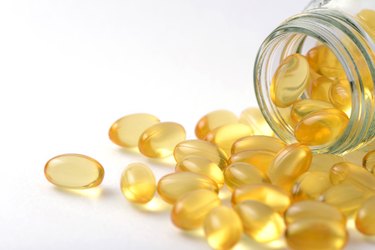
Vitamin D remains important throughout your life by playing a critical role in bone development, growth and reducing inflammation. Your body naturally makes this fat-soluble vitamin when exposed to sunlight. You can meet your daily vitamin D needs from food or through supplements. Using a calorie calculator helps you stay on track and ensures you're getting the necessary nutrition each day.
Read more: Foods With High Vitamin D
Video of the Day
Video of the Day
Avoid Vitamin D Deficiency
Dietary deficiencies come from many mechanisms, according to a January 2016 report in Physiological Reviews. For example, not having a well-balanced diet or not getting enough sunlight may cause you to have a vitamin D deficiency. Even people with a healthy lifestyle may have a deficiency if they other health issues that affect vitamin D production, such as kidney disease, or vitamin D absorption, such as Celiac disease.
Stay Aware of Your Risk
People at-risk for a vitamin D deficiency include those with lactose intolerance or milk allergy as well as those that follow a vegetarian or vegan lifestyle. The authors of a January 2018 paper in the International Archives of BioMedical and Clinical Research noted that 91 percent of the older adults surveyed had a deficiency as well. At the other end of the spectrum, breastfed children have a greater risk than bottle-fed children.
Medical conditions that cause your body to poorly digest fat may also cause a deficiency. These conditions include Crohn's disease, liver disease and ulcerative colitis. Individuals with obesity and patients with gastric bypass surgery also have significant risk.
Get Enough Vitamin D
The authors of a May 2015 paper in Mayo Clinic Proceedings described the controversy about how much vitamin D you need. Over the years, because vitamin D developed a reputation for being toxic, governments kept the recommended daily allowance low. But, new research shows that your body can tolerate higher levels than previously thought.
Scientists assess your circulating levels of vitamin D by measuring a metabolite called calcitriol. Most people can stay healthy by keeping their calcitriol between 50 and 125 nmol/L.
The Office of Dietary Supplements gives the recommended daily allowances for vitamin D. They range from 400 IU to 800 IU, depending on your age and gender. Getting this amount each day from taking a supplement or eating food will keep your calcitriol sufficiently high without damaging your body.
Read more: How Much Vitamin D Should I Take if I'm Over 60?
Avoid Excess Vitamin D
People taking vitamin D supplements may experience hypervitaminosis. Having too much vitamin D immediately increases your absorption of calcium and phosphorus, according to a January 2018 report in the Journal of Steroid Biochemistry and Molecular Biology. This increase creates a kidney-damaging calcium-phosphorus product. That product damages your vascular system by constricting your arteries and causing high blood pressure.
Additional symptoms of vitamin D toxicity range from heart problems to mental confusion. High levels of calcium can increase thirst and the need to urinate. They may also cause constipation.
Change Your Behavior
You can get enough vitamin D from sunlight, although there's some evidence for discouraging such exposure. Other people get a significant amount from lying in tanning beds. You should limit your ultraviolet light exposure once your calcitriol levels exceed 50 nmol/L or once you show signs of hypervitaminosis. At that point, you should also avoid eating foods rich in vitamin D and stop taking supplements featuring vitamin D.
Read more: The Effects of Sunlight & Fresh Air on the Body
Lower Your Calcium Intake
The interactions between vitamin D and calcium show that you need to watch your dietary calcium while having symptoms of vitamin D toxicity. During hypervitaminosis, you should avoid eating calcium-rich foods, including dark green vegetables and most seeds. You should also be wary of many animal products. All dairy items and some fish have abundant calcium.
Take Glucocorticoids and Diuretics
A doctor may prescribe glucocorticoids for lowering your calcium levels during vitamin D toxicity. These medications decrease the intestinal absorption of calcium. In mild cases, a diuretic like furosemide can resolve the symptoms of hypervitaminosis. This drug prevents fluids from accumulating in your body.
- Physiological Reviews: Vitamin D: Metabolism, Molecular Mechanism of Action, and Pleiotropic Effects
- International Archives of BioMedical and Clinical Research: Prevalence of Vitamin D Deficiency Among Geriatric Patients
- Mayo Clinic Proceedings: Vitamin D Is Not as Toxic as Was Once Thought
- National Institutes of Health Office of Dietary Supplements: Vitamin D Fact Sheet for Health Professionals
- Journal of Steroid Biochemistry and Molecular Biology: Vitamin D Supplementation Guidelines
- Endocrine Reviews: Vitamin D-Mediated Hypercalcemia: Mechanisms, Diagnosis, and Treatment
- Journal of the American College of Nutrition: Sunlight and Vitamin D: Necessary for Public Health
- Oman Medical Journal: Vitamin D Toxicity in Adults